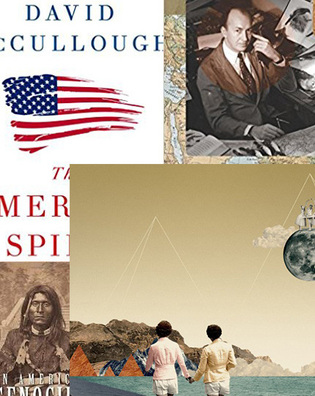 loading
loading
Arts & CultureOutputTo have your book, CD, app, or other work considered for Output, please send a copy to Arts Editor, Yale Alumni Magazine, PO Box 1905, New Haven CT 06509; or e-mail a copy or link to yam@yale.edu.  View full imageThe American Spirit: Who We Are and What We Stand For Over the course of his career, historian McCullough has delivered speeches in every state. Some of those featured in this eloquent collection are on highly specific topics: the clock, largely handmade around 1837, that still keeps time for Congress, for example. In another, he talks more broadly about the lessons and meaning of history—a quintessentially human endeavor that, then and now, can both serve as “an aid to navigation in such troubled, uncertain times” and “enlarge the experience of being alive.”
Young Narrator in the Breakers Eliza Bagg ’12 and Oliver Hill ’12, of the pop band Pavo Pavo, met playing in a Yale classical ensemble—then found their own rhythmic, swirling modern sound when they moved to Brooklyn and added three like-minded experimenters. Pavo Pavo embraces a highly produced, synthesizer-based quality that may seem ’70s-retro; one of the songs is titled “Annie Hall,” with the lyrics “Just do the disco kick, I’m hopeless.” But the band’s ethereal vocal sound is all its own.
The Lost Sketchbook of Edgar Degas In the fall of 1872, the French painter Edgar Degas came to New Orleans to stay for five months with his brother René and his American relatives, including René’s wife Estelle. There, Degas created some of his most haunting portraits. In this novel, Chessman posits that the painter recorded his ideas in a sketchbook. The book, Degas tells Estelle, “contains my life here. It’s very important to me.” When it resurfaces years later, the sketchbook—beautifully imagined by Chessman—holds some heartbreaking revelations about life and love.
My Jewish Year: 18 Holidays, One Wondering Jew “Most Jews in the United States are not living by the Jewish clock,” says Pogrebin; except for celebrating the High Holidays, Hanukkah, a pair of Passover seders, and a rare Sabbath or two, she was certainly one of them. But writing articles about “how observant families adhere to an annual system that organizes and anchors their lives,” made her feel adrift. After becoming a bat mitzvah at age 40, she decided to join those families in fully embracing all the year’s traditional Jewish celebrations. “I wanted to know what they knew. I had a hunch it would take me somewhere deeper,” Pogrebin writes. Did it ever. Mazel tov.
The Lives of Dillon Ripley: Natural Scientist, Wartime Spy, and Pioneering Leader of the Smithsonian Institution Born to railroad wealth, Sidney Dillon Ripley ’36 could have devoted himself to what Roger D. Stone calls “a comfortable country-squire life.” But Ripley, an “insatiable omnivore,” had a much broader agenda. In his fascinating biography, Stone traces the unlikely path of “this endlessly delightful, enigmatic man,” from his walks up Science Hill to forays into the wider world of museums, environmentalism, and espionage.
An American Genocide: The United States and the California Indian Catastrophe “California on the eve of contact with Europeans was an exuberant clamor of Native American economies, languages, tribes, and [hundreds of thousands of] individuals,” writes historian Madley. By 1846, when the United States wrenched control of the state from Spain, the native population had already been decimated. The 1880 census recorded only 16,277 natives. One horrifying reason, writes Madley in this excruciatingly well-documented book, was the “organized destruction of California’s Indian peoples under US rule.”
The comment period has expired.
|
|